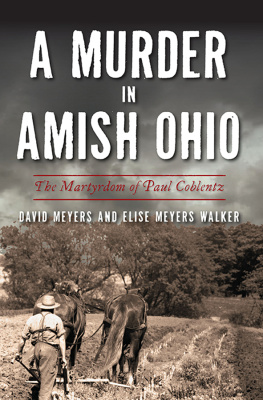An Amish Paradox

Y OUNG C ENTER B OOKS IN A NABAPTIST & P IETIST S TUDIES
Donald B. Kraybill, Series Editor
An Amish Paradox
Diversity & Change in
the Worlds Largest Amish Community
Charles E. Hurst and David L. McConnell

2010 The Johns Hopkins University Press
All rights reserved. Published 2010
Printed in the United States of America on acid-free paper
2 4 6 8 9 7 5 3 1
The Johns Hopkins University Press
2715 North Charles Street
Baltimore, Maryland 21218-4363
www.press.jhu.edu
Library of Congress Cataloging-in-Publication Data
Hurst, Charles E.
An Amish paradox : diversity and change in the worlds largest Amish community / Charles E. Hurst and David L. McConnell.
p. cm. (Young Center books in Anabaptist and Pietist studies)
Includes bibliographical references and index.
ISBN -13: 978-0-8018-9398-8 (hardcover : alk. paper)
ISBN -10: 0-8018-9398-4 (hardcover : alk. paper)
ISBN -13: 978-0-8018-9399-5 (pbk. : alk. paper)
ISBN -10: 0-8018-9399-2 (pbk. : alk. paper)
1. AmishOhioHolmes CountySocial life and customs. 2. AmishOhioHolmes CountySocial conditions. 3. AmishEducationOhioHolmes County. 4. AmishHealth and hygieneOhioHolmes County. 5. AmishOhioHolmes CountyEconomic conditions. 6. TechnologyReligious aspectsAmish. 7. Holmes County (Ohio)Social life and customs. 8. Holmes County (Ohio)Social conditions. I. McConnell, David L., 1959 II. Title.
F 497. H 74 H 87 2010
305.831077164dc22 2009018181
A catalog record for this book is available from the British Library.
Special discounts are available for bulk purchases of this book. For more information, please contact Special Sales at 410-516-6936 or specialsales@press.jhu.edu.
The Johns Hopkins University Press uses environmentally friendly book materials, including recycled text paper that is composed of at least 30 percent post-consumer waste, whenever possible. All of our book papers are acid-free, and our jackets and covers are printed on paper with recycled content.
Contents
Figures, Maps, and Tables
Figures
Maps
Tables
Preface
Studying the Amish is like undertaking a great detective adventure. There are detours, hidden treasures, unexpected discoveries, and clues to Amish culture and lifestyle lying all around. But as soon as you think you have a firm grasp on an issue, it slips away. You find exceptions and differences, and you begin to realize how misleading it is to jump to conclusions. You learn that it is dangerous to enter the study with a know-it-all attitude or a fixed theoretical framework. The research humbles but excites you because you become increasingly aware of the richness and depth of this living culture.
One of the many joys experienced in our exploration of the Amish in the Holmes County Settlement has been the twists and turns encountered on our journey. Because of the complexity and changing face of this settlement, the adventure has never been boring. Popular treatments of the Amish too frequently generalize inappropriately, focus on sensationalist incidents, or merely slide along the surface without ever penetrating the reality of Amish society. And while there are numerous excellent scholarly books on the Amish, they have tended to focus on other settlements, such as those in Pennsylvania and Indiana, even though the Holmes County Settlement in Ohio is the largest and perhaps the most complex in the world. It is on the latter community that our study focuses. (For convenience and because the settlement is centered around Holmes County, we use the term Holmes County Settlement throughout the book. In other works, the same settlement is sometimes referred to as the Wayne-Holmes Settlement or the Wayne-Holmes-Tuscarawas Settlement. In fact, it includes small parts of Wayne, Stark, Tuscarawas, Coshocton, Knox, and Ashland counties.)
To be Amish means to keep oneself separate from the wider society while at the same time being able to negotiate with it. This is an interminable struggle, one that contributes mightily to the dynamism of the Holmes County Settlement. This struggle has numerous faces and manifests itself in many forms. Among these are the ongoing negotiations between the individual and the community, between freedom and regulation, and between tradition and modernity. It is within the crucible of these crosscutting and conflicting forces that Amish behavior and culture are generated. Like the polarities of a magnet, the elements within these pairs often repel each other but also often reach accommodation and create fascinating mixtures.
During the early months of our fieldwork and on numerous other occasions, we experienced these unlikely mixtures and the sense of paradox that accompanied them. Sitting quietly next to an Amish friend on our way to the Heritage Historical Library in Aylmer, Canada, we were startled when the sound of his cell phone broke the silence in the car. Eagerly awaiting the arrival of parents who were bringing a hot lunch to schoolchildren, we were surprised when a pizza delivery truck pulled into the schoolyard, followed minutes later by a horse and buggy loaded with soft drinks and salad. In another instance, an Amish teacher, hearing of our interest in a particular lesson plan, opened a cupboard and proceeded to run off a color copy of it on his battery-powered copy machine. In this community that so often emphasizes cooperation and mutual dependence, we also watched Amish boys and girls go head to head in front of the class in a timed competition to solve math problems. And when students arrived for a school campout, we noticed that they sported the latest Nike and Adidas travel bags, footwear, and camping gear (but only in dark colors).
Such surprises, of course, said as much about our own expectations of the Amish as they did about the realities of Amish life. Mixtures like these are not anomalies; they are interwoven throughout the fabric of Amish culture and characterize our substantive discussions of religion, family, education, economy, and health care. The central focus of our book is the diversity created by these seemingly unlikely combinations and the border work that they require between Amish affiliations and between Amish and English (non-Amish) societies. Challenging a singular view of Amish culture and identity, we show how the interplay of internal tensions and external pressures affects integration and separation in different contexts.
The Holmes County Settlement is rife with diversity, internal disagreements, and varying adaptations to the conflicting forces that members must face. We find self-made Amish millionaires alongside struggling dairy and produce farmers; successful female entrepreneurs next door to stay-at-home wives; fervent adherents of public schooling and of homeschooling as well as supporters of parochial education within the same church district; and Amish youth who run wild even as their peers reject the period known as rumspringa altogether. Much of this diversity is caused by the coexistence of Swartzentruber, Andy Weaver, Old Order, New Order, and even New New Order affiliations within the Holmes County setting.
Over the past few decades, the tensions created by all these pressures have intensified as Amish settlements across America have undergone a remarkable economic transformation. To the surprise of many, as Amish enterprises and other forms of nonfarming employment have prospered, the retention rates of Amish youth have grown to an all-time high. To date, however, there has been no comprehensive analysis of the cultural negotiations, tensions, and contradictions unleashed by these changes in Ohios Holmes County Settlement. Based on more than ten years of experience with the local Amish community and seven years of systematic field research, including extensive interviewing and survey data, our book analyzes cultural continuities and changes in the worlds largest and most diverse Amish community. For those who are interested, we describe our methods of data collection more fully in .
Next page







![Beverly M Lewis] - The Beverly Lewis Amish Heritage Cookbook](/uploads/posts/book/96304/thumbs/beverly-m-lewis-the-beverly-lewis-amish-heritage.jpg)


